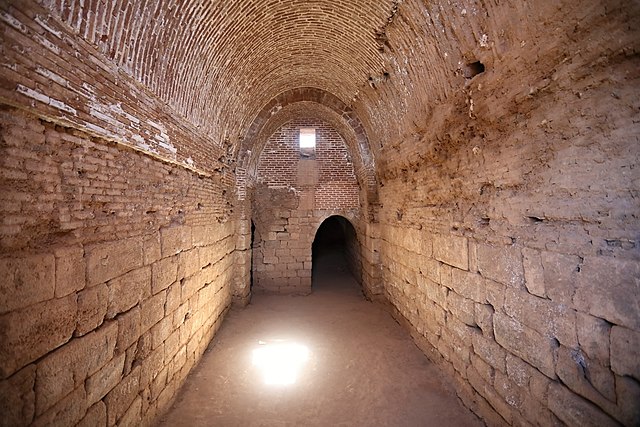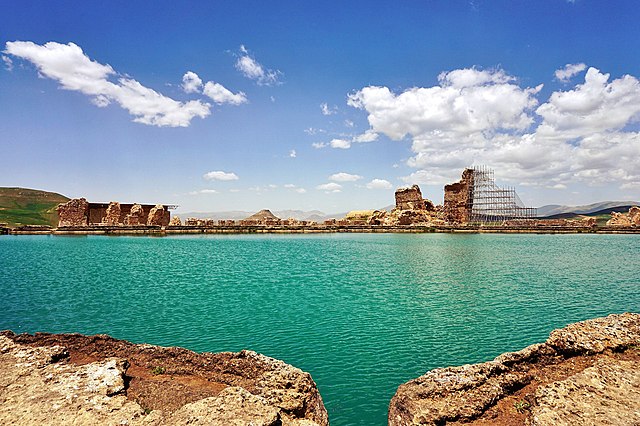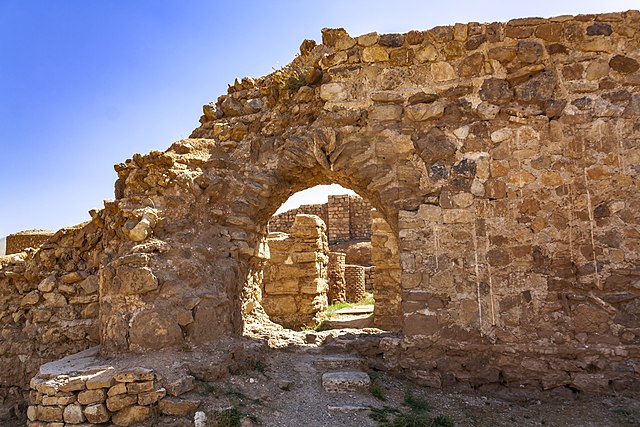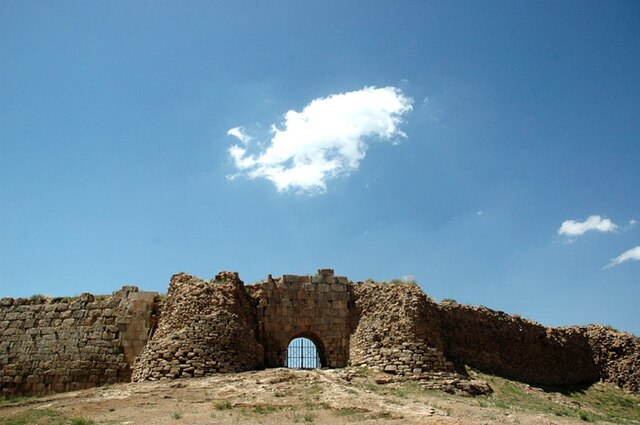Table of Contents
Situated amidst the stunning scenery of West Azarbaijan, Iran, Takht e Soleyman (also Takht e Sulaiman) stands as a time capsule from the days of the mighty Sasanian Empire. Located between Urmia and Hamadan, near the charming town of Takab, this extraordinary site has been recognized as a World Heritage Site since July 2003, blending history with nature seamlessly. Perched on a hill shaped by a peaceful spring pond, Takht-e-Soleyman offers a breathtaking sight.
Exploring this ancient enclave unveils a captivating tale. Adur Gushnasp, an ancient fire temple from the Sassanid era, tells stories of bygone civilizations. Through centuries of evolution, it transformed into a mosque during the Ilkhanid period, showcasing the enduring exchange of cultures. Stepping into its historic walls feels like stepping back in time, immersing oneself in ancient rituals and ceremonies.
At the heart of Takht e Soleyman lies the revered Azargoshasb Fire Temple, witness to the coronation of Sasanian kings, symbolizing the authority of Zoroastrianism and Sassanid rule for centuries. Despite the passage of time, the remains of this sacred place, known as the Throne of Solomon, stand as a testament to a glorious past—a reminder of the legacy left by those who once called this place home.
Takht e Soleyman History
Amidst the rocky terrain of northwestern Iran lies Takht e Soleyman, an ancient marvel built on a unique mound-shaped by a special spring. This mound, oval in shape and formed by the flow of a deep spring, is quite big, stretching about 1,150 by 1,800 feet. The spring’s water is rich in calcium, which has created a tall limestone formation rising 200 feet above the surrounding land.
People have cleverly used this water for irrigation, making the fields around it very fertile. At the heart of this landscape lies a large lake, about 260 by 400 feet, reaching depths of 400 feet at its lowest point, holding tales of ancient legends and human creativity.
The story of Takht e Soleyman or Takht e Sulaiman history is a tapestry woven with the histories of ancient civilizations and religious reverence. It began in the distant past, around the 1st millennium BCE, witnessing the footprints of the Achaemenian and Parthian dynasties. However, it was during the Sasanian era that Takht e Soleyman gained spiritual significance, becoming a Zoroastrian sanctuary in the 5th century CE.
Here, the revered fire altar, Adur Gushnasp, found its home within a grand temple. Despite facing challenges from time and conquests, Takht e Soleyman remained a symbol of faith amid the changing tides of empires. Yet, as centuries passed and empires crumbled, the winds of change swept over its sacred grounds, relegating it to the pages of history, where whispers of ancient times mingle with the echoes of a once vibrant past.
Takht e Soleyman Structure

Encircling Takht e Sulaiman Iran is a big oval wall, kind of like a giant circle. It’s really thick, about 5 meters, and super tall at 14 meters. Imagine walking around it and it’s over 1,200 meters long! Along this wall, there are 38 towers shaped like cones, standing tall and strong. They were built ages ago during the Sassanian time, showing how smart people were about defense back then.
Once you’re past the old walls, you step into a new part built during the Ilkhanan time. It’s like they added a new doorway next to the old one in the south. It’s cool how they connected the old and the new, blending them together. Passing through these doorways feels like traveling through history, where you can almost hear the stories of the past echoing through the stones.
The Relics of Takht e Soleyman

Takht e Soleyman Lake
When we arrive at the Takht e Soleyman area, our eyes are immediately drawn to the stunning view of the Takht e Soleyman lake right in front of us. This complex is situated next to a lovely natural lake where the water boils and rises from a depth of 120 meters. However, it’s important to note that this water isn’t safe to drink or use for farming. Stories have been passed down over the years about treasures hidden in the lake. Legend has it that during times of conflict, from the time of Cyrus the Achaemenid to the Sassanids, valuable items were thrown into the lake to keep them safe from enemies.
Explorations by archaeologists have revealed evidence of human activity in this area. Historians tell tales of significant events, such as the belief that the Holy Grail of Jesus Christ was kept here. It’s said that this city, where Jesus supposedly drank on the night before his crucifixion, holds profound historical importance. This rich history and folklore have led to Takht e Soleyman’s inclusion on the UNESCO World Heritage List and its recognition as a national monument. Amidst its calm waters and storied past, the lake serves as a timeless reminder of days gone by.
Soleyman Prison Mountain
Just three kilometers to the west of Takht e Soleyman stands Prison Mountain, a peculiar cone-shaped formation etched by ancient waters. Long ago, from 830 to 660 BC, it served as a sacred spot for worshippers of the Manichaean faith, drawing believers from far and wide. Even today, the mountain whispers stories of its past, accompanied by the soothing presence of healing hot springs dotting its surroundings.
Yet, beyond its spiritual allure, Prison Mountain holds mysteries hidden beneath its rocky exterior. In the days of the Azargoshasb fire temple’s glory, it was repurposed by the Sassanids as a fortress-like prison. Archaeologists speculate on its transformation from a submerged sanctuary to its current form, pondering the significance of a mystical wall encircling its base. And within its depths lies a spectacle: springs and gases swirling in silent tribute to a forgotten era, where even the worn walls of a sparkling spring endure within the mountain’s core.
Anahita Temple
In the northeast of the lake lies the Anahita Temple, one of the top Iran temples, honoring the ancient Iranian goddess of water. The temple’s presence hints at a special purpose. Between two peaks, when it rains, a lake forms from melted snow, while below, a spring flows. This spring was vital for the temple’s priests, providing them with drinking water. North of Takht-e Soleyman Lake, the Azargashsab Fire Temple stands as a significant historical landmark in the complex.
In this serene corner, the Anahita Temple and Azargashsab Fire Temple symbolize the deep connections between earth and spirit, water and fire. They invite visitors to contemplate the ancient bond between nature and divinity, echoing through the ages in quiet reverence.
FAQs about Takht e Soleyman
Q1: Where is Takht-e-Sulaiman now?
A1: The archaeological ensemble called Takht-e Soleyman (“Throne of Solomon”) is situated on a remote plain surrounded by mountains in northwestern Iran’s West Azerbaijan province.
Q2: What is the history of Takht-e Soleyman?
A2: In the past, Takht-e Soleyman was called Shiz until early Islamic times. Then, during the Ilkhanid period, it was known as Soqurluq, and eventually, it got its current name, Takht-e Soleyman, after the Timurid takeover of Persia in the 15th century. People have been living in this area since around the first thousand years BC.
Q3: Which temple is also known as Takht-e Suleman?
A3: The archaeological site Azargoshasb, also known as Takht-e-Soleiman in Western Azerbaijan, is a UNESCO World Heritage site. In ancient times, during the Sassanian era, it housed three Zoroastrian fire altars. Kings and warriors would visit these old fire temples to worship.
Q4: Why Takht e Sulaiman is called Takht e Sulaiman?
A4: Legend has it that Prophet Solomon once climbed this mountain and peered out over the land of South Asia. At that time, the land was shrouded in darkness. He decided not to venture into this unknown territory and instead turned back. The mountain was then named after him, according to a tale recounted by Ibn Battuta.
Q5: What is Takht-e-Sulaiman in English?
A5: Takht-e Soleyman, which means “the Throne of Solomon” in Persian and Sughurlukh in Turkish, translating to “a place abounding in marmots,” was constructed in the thirteenth century during the Ilkhanid dynasty. It served as a summer retreat and hunting palace.
Last Words: Discover the Best of Takht e Soleyman with a Customized Tour
Takht e Soleyman is an ancient place in Iran from the Sasanian Empire days. It’s located between Urmia and Hamadan, close to Takab town, about 400 km west of Tehran. This special spot has been a World Heritage Site since July 2003, blending history and nature. Perched on a hill by a spring pond, it’s truly a sight to see.
When you’re thinking about exploring Takht e Sulaiman Iran, it’s smart to consider a customized tour. That’s where To Iran Tour comes in. We specialize in creating Iran Tours that match your preferences. Our goal is simple: to plan a trip that’s exactly what you want, so you can enjoy every moment in Iran.
With To Iran Tour, you’re not just a tourist – you’re a guest, ready to explore Iran’s wonders in a way that’s perfect for you. Let us help you make memories that will last a lifetime.


